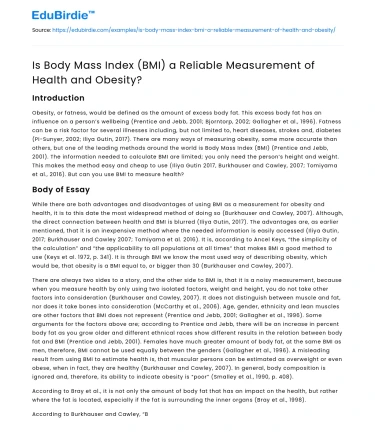Introduction
Obesity, or fatness, would be defined as the amount of excess body fat. This excess body fat has an influence on a person’s wellbeing (Prentice and Jebb, 2001; Bjorntorp, 2002; Gallagher et al., 1996). Fatness can be a risk factor for several illnesses including, but not limited to, heart diseases, strokes and, diabetes (Pi-Sunyer, 2002; Iliya Gutin, 2017). There are many ways of measuring obesity, some more accurate than others, but one of the leading methods around the world is Body Mass Index (BMI) (Prentice and Jebb, 2001). The information needed to calculate BMI are limited; you only need the person’s height and weight. This makes the method easy and cheap to use (Iliya Gutin 2017, Burkhauser and Cawley, 2007; Tomiyama et al., 2016). But can you use BMI to measure health?
Body of Essay
While there are both advantages and disadvantages of using BMI as a measurement for obesity and health, it is to this date the most widespread method of doing so (Burkhauser and Cawley, 2007). Although, the direct connection between health and BMI is blurred (Iliya Gutin, 2017). The advantages are, as earlier mentioned, that it is an inexpensive method where the needed information is easily accessed (Iliya Gutin, 2017; Burkhauser and Cawley 2007; Tomiyama et al. 2016). It is, according to Ancel Keys, “the simplicity of the calculation” and “the applicability to all populations at all times” that makes BMI a good method to use (Keys et al. 1972, p. 341). It is through BMI we know the most used way of describing obesity, which would be, that obesity is a BMI equal to, or bigger than 30 (Burkhauser and Cawley, 2007).
Save your time!
We can take care of your essay
- Proper editing and formatting
- Free revision, title page, and bibliography
- Flexible prices and money-back guarantee
There are always two sides to a story, and the other side to BMI is, that it is a noisy measurement, because when you measure health by only using two isolated factors, weight and height, you do not take other factors into consideration (Burkhauser and Cawley, 2007). It does not distinguish between muscle and fat, nor does it take bones into consideration (McCarthy et al., 2006). Age, gender, ethnicity and lean muscles are other factors that BMI does not represent (Prentice and Jebb, 2001; Gallagher et al., 1996). Some arguments for the factors above are; according to Prentice and Jebb, there will be an increase in percent body fat as you grow older and different ethnical races show different results in the relation between body fat and BMI (Prentice and Jebb, 2001). Females have much greater amount of body fat, at the same BMI as men, therefore, BMI cannot be used equally between the genders (Gallagher et al., 1996). A misleading result from using BMI to estimate health is, that muscular persons can be estimated as overweight or even obese, when in fact, they are healthy (Burkhauser and Cawley, 2007). In general, body composition is ignored and, therefore, its ability to indicate obesity is “poor” (Smalley et al., 1990, p. 408).
According to Bray et al., it is not only the amount of body fat that has an impact on the health, but rather where the fat is located, especially if the fat is surrounding the inner organs (Bray et al., 1998).
According to Burkhauser and Cawley, “BMI is a deeply flawed measure” and researchers should focus on other ways to measure health and obesity (Burkhauser and Cawley, 2007, p. 527). The ways of measuring obesity could include, but are not limited to, measurements of percent body fat, the foot-to-foot technique, skinfold, waist-to-hip ratio and waist circumference. These are more accurate ways to measure the actual body fat (Prentice and Jebb, 2001; Burkhauser and Cawley, 2007; Iliya Gutin, 2017). Even though BMI does not take all the necessary factors into considerations, BMI can still give a rough overview of a population’s health, primarily in the cases of high BMIs (Iliya Gutin, 2017).
Conclusion
The articles above argue that BMI has too many big gaps to properly be able to measure obesity and overall health. They argue that, because it does not take any factors into consideration other than height and weight, it is too inaccurate.
Although, the general attitude towards BMI as a measurement for health is negative, BMI is still the most commonly used measurement around the world, due to the easy and inexpensive way to perform the test, and the general idea it gives you, about a population’s overall health.
Implications
Is health only being physically fit and in the normal range of the BMI? How is mental health affected by having a low, normal, or high BMI? There is a huge focus on body image, but how does that effect mental health? If you measure by only using numbers (weight and height) you can dehumanize people, who become just a number in a statistic. Would more personal measure better reflect the overall health of the persons?






 Stuck on your essay?
Stuck on your essay?

